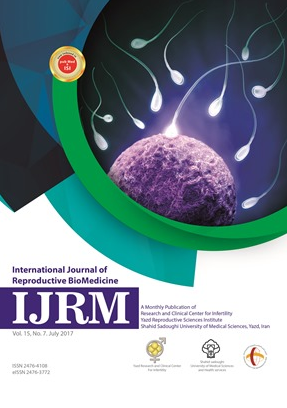
International Journal of Reproductive BioMedicine
ISSN: 2476-3772
The latest discoveries in all areas of reproduction and reproductive technology.
The effect of Myo-inositol on sperm parameters and pregnancy rate in oligoasthenospermic men treated with IUI: A randomized clinical trial
Published date: Oct 01 2019
Journal Title: International Journal of Reproductive BioMedicine
Issue title: International Journal of Reproductive BioMedicine (IJRM): Volume 17, Issue No. 10
Pages: 749 - 756
Authors:
Abstract:
Background: In about 40% of the couples, the cause of infertility problems is attributed to men because of low sperm production and disturbed motility of sperm. Pieces of evidence show that Myo-inositol has a potential role for the treatment of sperm morphology and male fertility.
Objectives: This study aimed to determine the effect of Myo-inositol on the sperm parameters and fertility rate in patients with oligoasthenospermia treated by intrauterine insemination (IUI).
Materials and Methods: This study was a randomized clinical trial conducted on 37 patients with oligoasthenospermia treated by IUI during 2016-2017. In this study, the patients were randomly divided into two groups of oligoasthenospermia treated with (Case group) and without Myo-inositol (Control group). The case group received 0.5 ml of Myo-inositol with a concentration of 2 mg/ml and incubated at 37°C incubator for 2 hr, but the control group had no interventions.
Results: The results of this study showed that although there was no significant difference in sperm parameters including sperm motility and concentration before processing with Myo-inositol in the case group, but there was a significant increase in sperm motility during the treatment with Myo-inositol. The therapeutic effect of this method was confirmed on induction of pregnancy in 18% of the treated patients, in such a way that was about twice greater than those who did not receive the drug.
Conclusion: According to the results of this study, the use of Myo-inositol is efficient enough to change sperm parameters to increase the chance of fertility.
Key words: Myo-inositol, Pregnancy, Sperm, Motility, Oligoasthenospermic.
References:
[1] Diaz JR, De Las Cagigas A, Rodriguez R. Micronutrient deficiencies in developing and affluent countries. Eur J Clin Nutr 2003; 57 (Suppl.): S70–72.
[2] Stachecki JJ, Armant DR. Transient release of calcium from inositol 1, 4, 5-trisphosphate-specific stores regulates mouse preimplantation development. Development 1996; 122: 2485–2496.
[3] Beemster P, Groenen P, Steegers−Theunissen R. Involvement of inositol in reproduction. Nutr Rev 2002; 60: 80–87.
[4] Ciotta L, Stracquadanio M, Pagano I, Carbonaro A, Palumbo M, Gulino F. Effects of myo-inositol supplementation on oocyte’s quality in PCOS patients: a double blind trial. Eur Rev Med Pharmacol Sci 2011; 15: 509–514.
[5] Ortmeyer HK. Dietary myoinositol results in lower urine glucose and in lower postprandial plasma glucose in obese insulin-resistant rhesus monkeys. Obes Res 1996; 4: 569–575.
[6] Papaleo E, Unfer V, Baillargeon JP, De Santis L, Fusi F, Brigante C, et al. Myo-inositol in patients with polycystic ovary syndrome: a novel method for ovulation induction. Gynecol Endocrinol 2007; 23: 700–703.
[7] Hinton BT, White RW, Setchell BP. Concentrations of myoinositol in the luminal fluid of the mammalian testis and epididymis. J Reprod Fertil 1980; 58: 395–399.
[8] Colone M, Marelli G, Unfer V, Bozzuto G, Molinari A, Stringaro A. Inositol activity in oligoasthenoteratospermia– an in vitro study. Eur Rev Med Pharmacol Sci 2010; 14: 891– 896.
[9] Liu DY, Clarke GN, Baker HW. Hyper-osmotic condition enhances protein tyrosine phosphorylation and zona pellucida binding capacity of human sperm. Hum Reprod 2005; 21: 745–752.
[10] Cryns K, Shamir A, Van Acker N, Levi I, Daneels G, Goris I, et al. IMPA1 is essential for embryonic development and lithium-like pilocarpine sensitivity. Neuropsychopharmacology 2008; 33: 674–684.
[11] Martínez-Heredia J, de Mateo S, Vidal-Taboada JM, Ballesca JL, Oliva R. Identification of proteomic differences in asthenozoospermic sperm samples. Hum Reprod 2008; 23: 783–791.
[12] Speroff L, Fritz MA. Clinical gynecologic endocrinology and infertility. London; lippincott Williams & wilkins: 2005.
[13] Barratt CL, Mansell S, Beaton C, Tardif S, Oxenham SK. Diagnostic tools in male infertility-the question of sperm dysfunction. Asian J Androl 2011; 13: 53–58.
[14] Tomlinson M, Lewis S, Morroll D, British Fertility Society. Sperm quality and its relationship to natural and assisted conception: British Fertility Society Guidelines for practice. Hum Fertil 2013; 16: 175–193.
[15] van der Steeg JW, Steures P, Eijkemans MJ, F Habbema JD, Hompes PG, Kremer JA, et al. Role of semen analysis in subfertile couples. Fertil Steril 2011; 95: 1013–1019.
[16] Chauvin TR, Griswold MD. Characterization of the expression and regulation of genes necessary for myo-inositol biosynthesis and transport in the seminiferous epithelium. Biol Reprod 2004; 70: 744–751.
